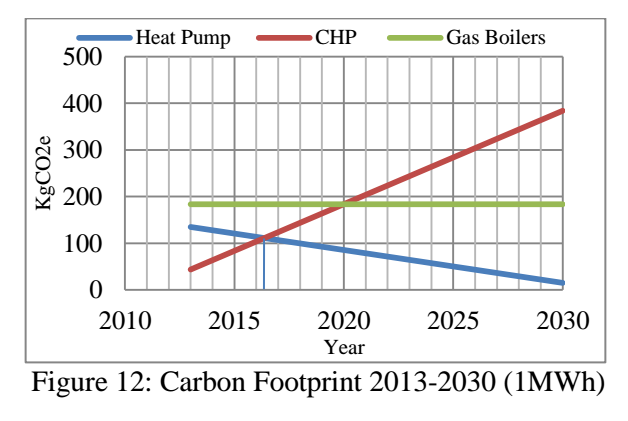- Heating
- Currently Gloucester has, in common with most of Britain, poorly insulated housing stock, mostly heated from natural gas. In 2018 Gloucester has an estimated 60,000 houses for a population of about 130000 people. link
- The average Energy Performance of houses is the UK was about about 30000 kwh per annum per household at a current cost at 4p /Kwh costs approximately £1200 per household .
- This could be improved dramatically by insulation and draft proofing; for instance an average 2 bedroom terrace with a D rating Energy Performance Certificate (EPC) uses approximately 22000Kwh energy a year for heating and hot water at a cost of approximately £880 a year at 4p/Kwh. According to HM Government Energy Performance Certificate the energy use of this terrace could be cut by 7500 Kwh per year at a cost of approximately £4 to £5000 to give an annual saving on heating and hot water of around £300 ie the household cost of heating and hot water would drop from £880 per year to £580 .
- However for the householder on a low budget it has to be considered that borrowing money to finance this may be more than the money saved. Central and local government should be providing low interest loans for those who cannot afford this. For someone with savings of £5000 they wish to invest, income gained from these measures is likely equivalent to a 6% interest rate which is a much higher that could safely be obtained elsewhere. link
- It should be considered that a well built house, which is nearly all of them, will last hundreds of years and the cost of insulation should be considered in that context. So for instance £5000 borrowed over 40 years at 5% will cost approximately £300 per annum to pay back the capital and for the next 350 years the original investment will save future householders expensive heating bills and dramatically help combat climate change.
- Communal Heat Pump
Water Sourced Heat Pump
This is relatively new adaption of heat pump technology developed by star energy http://www.neatpumps.com/
A good video explaining the technology in laymens terms is given in an interview with Neatpumps by Robert Lewellyn here
- A paper costing this type of heat pump has been produced for Glasgow University , This explains “The introduction of a heat pump would potentially save the university £4.6M over 20 years with a payback of 3 years. Furthermore it will have the lowest carbon emissions by 2016 and emissions will continue to fall with the potential to provide carbon free heating.The analysis from this paper suggests that a 7.43 MW heating capacity heat pump system would be able to operate for the vast majority of the operation period (October to April)
The heat pump is the most cost effective, representing a saving of £1.75Mcompared to combined heat and power and a saving of £4.6M compared to gasboiler. The payback period for a heat pump is about 3 years. link

The Graph above is interesting because the calculations from Glasgow show the heat pump having near zero carbon emissions in 2030 against 200Kg CO2 per MWh for gas heating and from 50KgCO2 per MWh to near 400 for CHP (Combined Heat and Power). This is because Scotland has set a target to cut carbon emissions from electricity generation by more than four fifths by 2030. This will mean that the power production from a CHP plant will produce significantly more CO2 than just using near zero electricity thus making the total carbon output from CHP higher than using gas for heating plus near zero carbon electricity.
The UK as a whole has only set a target of around 40% renewable electricity and it is unclear as to whether that will be achieved without pressure to do so from the EU so the figures would be different.
- From Zoopla a fairly well insulated 2 bedroom terrace costs £312 per year using about 7800kw/h per year to heat The heatpump above using the Severn for its water source would heat 4115 similar houses. currently using £1,283880 of gas a year (at 4p/kw).
BioFuels
Ecotricity have built and are planning more electricity plants to run on Biofuel,currently grass. They say “Green gas is big opportunity for Britain – it can make a big contribution to reducing carbon emissions and making us more energy independent;and theoretically there’s enough non-food producing farmland in Britain to meet 95% of Britain’s domestic and commercial needs” link
According to their figures link
A typical Green Gas Mill at 5MW will require about 3,000 acres of grassland to supply 3,500 homes with all the gas they need. ( 1760 KWh per acre of grass) That’s less than one acre per household.The construction of 1,000 Green Gas Mills, each of 5MW capacity, would be enough to make up the current shortfall against our 12% target and would create around 15,000 jobs and pump £1.5 billion into the rural economy.In the long term, with domestic gas demand expected to fall, each 5MW Green Gas Mill should supply almost 5,000 homes.
Biowatch challenge Ecotricities figures here but in my view they are being unduly negative. It is probably true that Ecotricity may be being overly optimistic.
Though Ecotricity aim the green gas to replace household gas I would consider it very useful as a way of storing energy along with batteries, pumped hydro, and other technologies such as compressed air, gravity storage here etc.